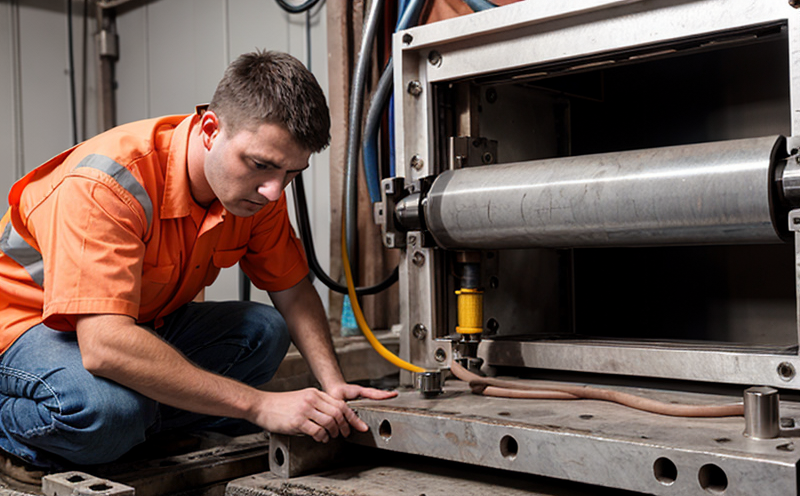EN 50289 Mechanical Bending Testing of Lighting Cables
The EN 50289 standard specifies the procedure for determining the resistance to mechanical bending stresses of flexible lighting cables. This test is crucial in ensuring that the cables can withstand the physical stresses they will encounter during installation and operation, particularly in environments where movement or flexing might occur.
The testing protocol outlined in EN 50289 involves subjecting a sample cable to repeated bends and twists under controlled conditions. The goal is to replicate real-world usage scenarios that could potentially lead to failure of the cable due to mechanical stress. Compliance with this standard helps manufacturers ensure their products meet stringent safety requirements, thereby protecting end-users from potential hazards.
The test setup typically includes a bending machine capable of applying specified bending radii and cycles. The specimen is clamped at one end while being subjected to multiple bends around the specified radius. The number of cycles can vary depending on the expected service life of the cable. After reaching this predetermined limit, the integrity of the cable’s insulation, conductors, and overall structure must be evaluated.
Compliance with EN 50289 is mandatory for products intended to be used in public spaces or environments where flexibility and durability are critical factors. This includes but is not limited to street lighting systems, building façade installations, and other applications requiring flexible electrical wiring that may experience repeated bending during use.
The standard also emphasizes the importance of proper specimen preparation prior to testing. It specifies guidelines on how samples should be cut from production lots so as not to introduce bias into results. Preparing specimens correctly ensures accurate assessment of a product’s ability to withstand mechanical stresses without compromising safety or performance.
When interpreting test results, it is essential to consider both pass/fail criteria and any visual inspections conducted after the bending cycle. Pass conditions usually involve no visible damage to insulation layers or conductors that could indicate weakness in the cable structure. Failing these criteria would suggest inadequate resistance against mechanical stresses, necessitating further investigation into design flaws or manufacturing processes.
For quality managers, compliance officers, and R&D engineers responsible for developing new products or ensuring existing ones meet regulatory standards, understanding EN 50289 is vital. By incorporating this testing procedure early in the development process, companies can identify potential issues before they become costly problems later on. This proactive approach not only enhances product reliability but also improves overall market confidence by demonstrating adherence to international safety norms.
In summary, EN 50289 serves as a critical benchmark for evaluating the mechanical robustness of flexible lighting cables used in various applications across different sectors. Its application ensures that these cables remain functional and safe even under challenging conditions encountered during their operational lifecycle.
Scope and Methodology
The scope of EN 50289 covers the mechanical bending testing of flexible lighting cables intended for use in public spaces or environments where flexibility and durability are paramount. The primary objective is to assess the ability of these cables to resist mechanical stresses without compromising safety or functionality.
- Test Setup: A bending machine capable of applying specified bending radii and cycles is used.
- Specimen Preparation: Samples are cut from production lots following prescribed procedures to ensure accurate results.
- Bending Process: The specimen is clamped at one end while being subjected to multiple bends around the specified radius. Cycles can vary based on expected service life.
- Evaluation Criteria: After reaching the predetermined limit, integrity of insulation, conductors, and overall structure must be evaluated for any visible damage that could indicate weakness in the cable structure.
The methodology outlined ensures consistent testing procedures across different laboratories, contributing to reliable data collection. Compliance with this standard is mandatory for products used in public spaces or environments where flexibility and durability are critical factors.
Environmental and Sustainability Contributions
Compliance with EN 50289 contributes significantly to environmental sustainability by promoting the use of reliable, long-lasting lighting systems. Flexible cables that pass this rigorous testing procedure are less likely to fail prematurely due to mechanical stress, reducing the frequency of replacements needed over time.
This extended lifespan translates into lower waste generation and resource consumption associated with frequent replacement cycles typical in poorly designed or tested products. Additionally, by ensuring higher quality standards right from the manufacturing stage, companies can contribute positively towards reducing energy consumption through more efficient lighting solutions.
The focus on durability also aligns well with global efforts aimed at minimizing electronic waste (e-waste). By improving product longevity, manufacturers help extend the useful life of their products before reaching end-of-life stages where disposal becomes necessary. This proactive approach supports broader sustainability goals by fostering responsible consumption practices among consumers and industry stakeholders alike.
Moreover, adhering to international standards like EN 50289 underscores a commitment to excellence in product development and quality assurance. Such initiatives enhance trust between suppliers and customers while promoting best practices within the lighting sector globally.





